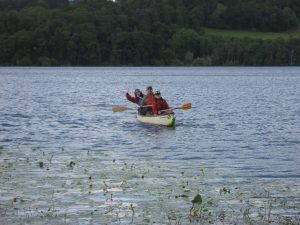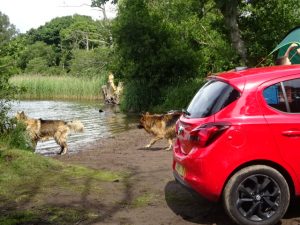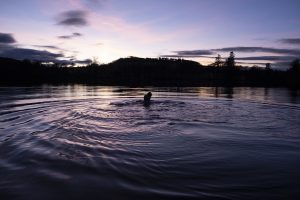The weekend of May 30-31, the Coronovirus lockdown was partially lifted by the Scottish government. After months of being confined to home, however large or small, Scots could theoretically go out and about, and while the large majority stayed put, thinking of others as much as themselves and so doing their best to keep us all safe, a significant few thought Buggar this for a laugh, we’re off!
And – with no pubs, cinemas or shopping malls open – off they drove, to Loch Lomond (from Glasgow way), Loch Tay and Loch Tummel, beaches along the Fifeshire coastline and any other scenically endowed stretch of water they could find on the touristic maps of mainstream and social media.

Looking northwards, across to Forneth House
One of these was Loch Clunie, a centrally placed jewel in a necklace of five freshwater lochs (lakes) strung along the Lunan Burn in the Lunan Valley, which connects Dunkeld and Blairgowrie, in Perthshire. It is a designated area of natural beauty, the main reason a proposed wind farm at Dulater was turned down at the highest level just last year.
Craiglush is just that: lush; Loch of the Lowes has protected species (famed osprey).
Butterstone seems to have fiercely defended fishing rights; you only ever see rowing boats out in all weathers.
Beyond Clunie, there is Marlee, with soft fruit and Christmas trees farmed on the south side, and the northern shore now cut off from public access by wire (2019) and (significantly more recently) large boulders placed in unofficial and official laybys.
There is a sixth expanse of water, Rae Loch, just before Ardblair Castle on the A923 just before Blairgowrie, but this is not counted as part of the chain. Why?
Because in any rainfall, water overspills onto the roadway and flood signs lying along the sides of the road are lifted into place again. The reason? It is near clogged with rushes, and surrounded by swamp. This protects from intrusion, while driving motorists, cyclists and even walkers up the wall (not that there is one of course). And as long as the wrangling goes on between officialdom, and nature reservists who claim beavers have the right to do their thing, like chewing down trees and building dams, and rare species of flora require protection ahead of human wants and needs, nothing will change. It is quite simply allowed to be.
And then there is Clunie, right there in the middle and as popular now as it has been for centuries. *As Kenneth McAlpine united the Picts qnd Scots in 843, he chose Dunkeld as his capital and Clunie for the site of his summer hunting palace.

Late 19th century photograph, taken when the ‘castle’ was still visible and largely intact
Locals say that summer time has always been a bit of a noisy smoke-driven litter-strewn nightmare, with people from the cities and roundabout – tinkers, travellers and, since the 1970s, EU workers from the berry fields roundabout – coming for picnics and camping for as long as can be remembered.

Camping as it ought to be, in tune with nature, offending no-one

A wonderful way to learn about Clunie’s history and wildlife

Responsible camping: A big family party who brought not only dogs but their own toilet
But the weekend that restrictions were lifted in Phase 1 of exit from lockdown, Clunie made the news. Not only were there 60+ cars parked everywhere – on lanes, in fields, on verges – but some 400 people – mostly from Dundee and Glasgow – partied by night and day. It came to a head at 3am on Sunday morning when the estate manager for Forneth House – his family unable to sleep and anxious – confronted three drunken individuals on the lochside, and was stabbed.
The owners of Forneth House flew in the following day from the Netherlands to check on their property and the wellbeing of employees and establish exactly what happened.
It took days for local groups to clear the litter and debris left behind. It seems commonplace these days after music festivals and other weekend events, to just leave tents and equipment, or even dump it all in water. And as for the human waste…
Much aroused and worried, there came the call for a meeting to discuss the situation with a local councillor. And so within days some 30 individuals, including landowners and representatives from the various local groups who do their best to use the loch responsibly, met online by zoom.
The main problem, everyone felt, was that the loch’s shoreline is ‘owned’ by five different people: the owners of Forneth House (who demand privacy); a man who lives in Cornwall and is said to have bought a stretch of land at a public auction for £4,000; an area of what is called common grazing land but most probably does have an owner recorded way back in the mists of time; a 40 yard stretch of ‘beach’ supposedly used by a local family as their landing stage; and the rest all part of the Snaigow Estate, owned by Edward Cadogan, Lord Chelsea. It is Snaigow that ‘owns’ Loch Clunie’s waters, and this includes its famed island, an ancient crannog with historic links to Dunkeld.
After the meeting was over, I could not sleep, and sat up wondering why I felt so disconcerted. And then I woke up, realised …
All those involved had been talking about how they used the loch. Yet the most important voice was absent. The voice of Clunie Loch itself. Who spoke on its behalf? No-one. So I walked our labyrinth, asked if this lovely place that I have been visiting since 1951 and now regard as a close friend and neighbour, would like to have a word, say its piece. And so it spoke:
I listened to you all the other evening. I heard you talking of proprietorial ownership of land – my ever-changing ‘owned’ shoreline. I heard you talking about how much you enjoyed using me. Using me for fishing, row-boating, paddling and swimming, as your ancestors have done for centuries. But more recently, for paddle-boarding, something you call wild swimming, yoga, canoeing and kayaking. In the main, quiet and gentle pursuits and ones I can happily live with.
Do you ever wonder how I feel about it, though? Naturally my water is in constant flow, moving from where the Lunan burn enters to where it leaves under the bridge to continue on to Marlee, so in this respect I am constantly changing and evolving. But at heart I am the whole environment, living in a harmonious whole as One.
I am the trees that thrive near good water. So why do some of you – some, not all – tear me apart, rip me down, saw and cut into me; don’t you know that my green wood of a sap-full summer fails to burn?
I am the shrubs and trees and flowers that both protect and feed off me. And yet you have no respect, leaving not only unwanted goods but your urine and excrement to despoil me, in terms of my own wellbeing, and that of other more considerate visitors.
I am the fish and diverse water creatures that naturally plumb my depths for nutrients, but are forced to dive dive dive by jetskiis and motorboats. There are not many of these noisy polluting monsters, but the few that tear me up cause havoc and great distress.
I am the birds that live on and with me – swans, ducks and all the other water fowl that enjoy my peace and quiet. Imagine our terror when invaded; think about how long it takes it regain our trusting equilibrium.
I am the birds that fly above me. But not when our flight paths or circling food forays or nests are threatened. Then we think to move away, seek wilder safer places elsewhere. This is when I forsee degradation and loss and even death on our imminent horizon.
I am the awesome creatures that come to drink at night. Voles, beavers, deer…
And in my quiet waters – my usually cold, mostly dark, occasionally desperate waters – where lily stems writhe, seeking a grip on thrashing limbs, and algae will bloom to negative effect to all (except the algae) if conditions prevail – I hold my peace.I can sense the respect of those who show consideration, who are quietened and even healed by my own undemanding meditative existence. They leave more contemplative, more at one with themselves and nature at large.

Credit: Kelly McIntyre
But then there are others who arrive in a state of unconsciousness and leave no better improved. They light fires, smoking out wildlife and leaving me burned and hurt. They throw empty cans into me and leave smashed glass for wild creatures to tread on. Thoughtlessly, they use, dump and move on. A great time, I hear them shout, wholly ignorant of the cost.
So what can I do? How can I keep my environmental health and ravishing natural beauty intact?
If you cannot live in harmony with me, respect my existence as much as I want to respect your own, then please, I beg of you, just stay away.

Credit: Kelly McIntyre
* From MEMORIAL INSCRIPTIONS AT CLUNIE CHURCH with historical notes by Elma Rodger Wood. Published by the Dunkeld and Birnam Historical Sociey, 1996, 2006. Master sheets and photographs are now held in the Dunkeld Cathedral archives.

